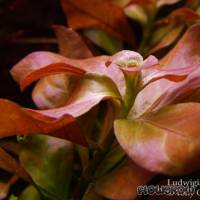



The classical aquarium plant Ludwigia repens originates from the south of the United States, Central Americal and the Caribbean, where it grows on the edges of all kinds of waterbodies (ditches, rivers, lakes, ponds). It frequently forms dense trailing populations in the shallow water, whose shoot tips grow over the water surface. In nature, L. repens is a highly variable (polymorph) species and hybridises easily with other Ludwigia species, which makes scientific identification of the various local forms very difficult.
Ludwigia repens is among the most common aquarium plants world-wide. There are several forms of this species in trade. An especially colourful variety with round leaves is sold under the name "Ludwigia mesakana" or "mesacana". Allegedly, L. "repens" 'Rubin' is not to be counted among the species L. repens but is rather close to L. glandulosa, and is supposed to be a hybrid (please see Ludwigia 'Rubin').
L. repens looks very similar to L. palustris and the hybrid L. palustris x repens, its main distinguishing characteristics is the flower structure of the emersed plant. The flowers of L. repens have four small yellow petals (see fig. 3) about as long as the green calyx tips, whereas in L. palustris the petals are completely absent (please see description of L. palustris). L. palustris x repens often forms less than four petals (or even none at all) shorter than the calyx tips. These petals are discarded very early in many cases. The leaf stalks of L. repens and L. palustris x repens are often comparatively shorter than those of L. palustris.
L. repens is one of the easiest-to-care-for red aquarium plants and grows well under relatively low light (0.4 watt per litre), and it does not need CO2 fertilisation. When planted under strong lights, it does not grow strictly upright but has a slated to horizontal habit, forming many lateral shoots. Its reddish colour is most intensive if it is not planted in the shade of other plants but gets sufficient light (0.5 watts per litre or above). Low levels of NO3 (approx. 5 mg/l), and a high phosphate content (1.5-2 mg/l) as well as a good provision of iron and micronutrients intensify the red hues of the plant even more. Some hobbyists have noticed that 9325 Kelvin light tubes also enhance the red colouration.
Propagation is very easy, as in all stem plants. Just cut off lateral or top shoots, which you re-plant in the substrate. The rest of the plant may be discarded. If left in the substrate it will form lots of new lateral shoots. As soon as the plant reaches the water surface its new growth assumes a trailing habit and also throws a great number of lateral shoots.
Ludwigia repens is a very versatile plant for aquascaping, setting red accents in the middle- or background or even serving as foreground plant in large aquaria, given that it is strongly trimmed on a frequent basis.
<a href="https://www.flowgrow.de/db/aquaticplants/ludwigia-repens" target="_blank"><img alt="Ludwigia repens" title="Ludwigia repens" src="https://www.flowgrow.de/db/widget/aquaticplants/ludwigia-repens" /></a>
[url=https://www.flowgrow.de/db/aquaticplants/ludwigia-repens][img]https://www.flowgrow.de/db/widget/aquaticplants/ludwigia-repens[/img][/url]
[widget=aquaticplants/ludwigia-repens]Ludwigia repens[/widget]